Regency Fireplace Products CitySeries New York View 40 Power Vent Owner's manual
- Category
- Fireplaces
- Type
- Owner's manual

City Series
®
Direct Vent Gas Power Vent Fireplace
Owners &
Installation Manual
STYLE MODEL
Single sided CV40EPV-NG / CV40EPV-LP
www.regency-fire.com
- Do not store or use gasoline or other flammable vapors and liquids in the vicinity of this or any other
appliance.
- WHAT TO DO IF YOU SMELL GAS
• Do not try to light any appliance.
• Do not touch any electrical switch: do not use any phone in your building.
Leave the building immediately.
• Immediately call your gas supplier from a neighbour's phone. Follow the gas supplier's
instructions.
• If you cannot reach your gas supplier, call the fire department.
- Installation and service must be performed by a qualified installer, service agency or the gas supplier.
Warning
Fire or explosion Hazard
failure to follow safety warnings exactly could result in serious
injury, death, or property damage.
919-924e
FPI FIREPLACE PRODUCTS INTERNATIONAL LTD. 6988 Venture St., Delta, BC Canada, V4G 1H4
04.09.20
San Francisco Bay
CB40E-NG1
Installation video
http://bit.ly/2vjpzmr
Installer: Please complete the details on the back cover
and leave this manual with the homeowner.
Homeowner: Please keep these instructions for future reference.
Tested by:
Certified to/Certifié pour: CSA 2.17-2017
ANSI Z21.88-2017
CSA 2.33-2017

2 | CV40EPV City Series
This appliance may be installed in an aftermarket, permanently lo-
cated, manufactured home (USA only) or mobile home, where not
prohibited by local codes.
This appliance is only for use with the type of gas indicated on the
rating plate. This appliance is not convertible fore use with other
gases, unless a certified kit is used.
To the New Owner:
Congratulations!
You are the owner of a state-of-the-art Gas Fireplace by REGENCY
®
. The City Series are hand crafted appliances and have
been designed to provide you with all the warmth and charm of a wood fireplace at the flick of a switch. The CV40EPV City
Series has been approved by Intertek for both safety and efficiency. As it also bears our own mark, it promises to provide you
with economy, comfort and security for many trouble free years to follow. Please take a moment now to acquaint yourself with
these instructions and the many features of your Regency
®
Fireplace.

CV40EPV City Series | 3
MANUFACTURED MOBILE HOME REQUIREMENTS
INFORMATION FOR MOBILE/MANUFACTURED HOMES AFTER FIRST SALE
This Regency
®
product has been tested and listed by Intertek as a Direct Vent Wall Furnace to the following standards: to Vented Gas
Fireplace Heaters ANSI Z21.88-2017 • CSA 2.33-2017 and Gas-fired Appliances for Use at High Altitudes CSA 2.17-2017.
This Direct Vent System Appliance must be installed in accordance with the manufacturer's installation instructions and the Manufactured
Home Construction and Safety Standard, Title 24 CFR, Part 3280, or the current Standard of Fire Safety Criteria for Manufactured Home
Installations, Sites, and Communities ANSI/NFPA 501A, and with CAN/CSA Z240-MH Mobile Home Standard in Canada.
This appliance installation must comply with the manufacturer's installation instructions and local codes, if any. In the absence of local codes
follow the current National Fuel Gas Code, ANSI Z223.1 and the current National Electrical Code ANSI/NFPA 70 in the U.S.A., and the
current CAN/CGA B149 Gas Installation Code and the current Canadian Electrical Code CSA C22.1 in Canada.
This Regency
®
mobile/manufactured home listed appliance comes factory equipped with four 1/4" diameter holes located near each corner
of the base. Fasten the fireplace in place using screw, inserted through the holes.
This appliance comes equipped with a dedicated #8 Ground Lug for attachment of the ground wire to the steel chassis as applicable to local
codes. See the "Wiring Diagram" section.
The appliance, when installed, must be electrically grounded in accordance with local codes or, in the absence of local codes, with the
National Electrical Code, ANSI/NFPA 70, or the Canadian Electrical Code, CSA C22.1.
This appliance may only be installed in an aftermarket permanently located, manufactured home (U.S.A only) or mobile home, where not
prohibited by local codes.
This appliance can only be used with the type of gas indicated on the rating plate. This appliance is not convertible for use with other cases,
unless a certified kit is used.
Ensure that structural members are not cut or weakened during installation.

4 | CV40EPV City Series
table of contents
Owner's Information
Installer's Information
Locating Your Gas Fireplace ........................................19
Unit Assembly Prior to Installation ...............................19
General Safety Information ..........................................21
Installation Checklist ....................................................21
Heatwave Duct System ...............................................21
Clearances CV40EPV .................................................22
Mantel Clearances CV40EPV .....................................23
Mantel Leg Clearances ................................................23
Framing Dimensions CV40EPV ...................................24
Chase Vent Installation ................................................25
Chase Venting .............................................................28
Optional Front Grill Installation ....................................29
Wall Board/Drywall Installation ....................................30
Framing and Finishing Inset Installations CV40EPV ...31
TV Recessed into Wall ................................................32
Maximum TV Recess ...................................................32
TV Flush with Hearth ...................................................32
Wall Mount On / Off Switch Installation .......................33
Exterior Vent Termination Locations ............................34
4"x 6-5/8" Rigid Pipe Cross Reference Chart ..............35
Venting Arrangements for Horizontal Terminations
- End of Line Horizontal Vent Chart ...........................37
Vent Restrictor Position ...............................................37
Venting Arrangements for Horizontal Terminations
-Inline Horizontal Vent Chart ......................................38
Venting Arrangement for Vertical Terminations
-Inline Power Vent ......................................................39
Vertical Inline Power Vent Terminations - Rigid Pipe ...40
Venting Arrangements for Vertical Terminations
-Flex Pipe ..................................................................41
Horizontal Terminations-Inline Power Vent
-4" x 6-5/8" Flex Vent .................................................42
Horizontal Terminations - Inline Power Vent
-4" x 6-5/8" Rigid Pipe ...............................................43
Horizontal Terminations - End of Line Power Vent
-4" x 6-5/8" Rigid Pipe ...............................................44
Copy of Safety Decal .....................................................5
Important Message ......................................................7
Before You Start .............................................................7
General Safety Information ............................................8
Lighting Procedure ........................................................9
Shutdown Procedure .....................................................9
Copy of the Lighting Plate Instructions ........................10
Proflame II Remote Control Operating Instructions .....11
Inner Glass Panel (Firebox Glass) ..............................15
Outer Safety Glass Panel (Barrier Glass) Installation . . 16
Maintenance Instructions ............................................17
Log Replacement ........................................................17
Glass Gasket ...............................................................17
Glass ...........................................................................17
Glass Replacement .....................................................17
Warranty .....................................................................94
End of Line Power Vent Dimensions ............................45
Gas Power Vent Installation - Framing
-Inline Power Vent Terminations .................................46
Power Vent Terminal Installation-Inline Power Vent
Terminations ..............................................................47
Gas Power Vent Installation Clearance Requirements
Inline Power Vent Terminations ....................................48
Unit Installation with Horizontal Termination-End of
Line Power Vent-4" x 6-5/8" Rigid Venting .................49
Unit Installation with Horizontal Termination-End of
Line Power Vent-4" x 6-5/8" Flex Venting ...................50
Verical Inline Power Vent Terminations-Rigid Pipe ......51
Verical Inline Power Vent Terminations-Flex Pipe ........52
Vertical Flue Extension Kit-Horizontal Power Vent Kit . 54
Ceiling Firestop / Firestop Spacer ...............................55
Gas Power Vent Install-Wiring Power Vent to Unit .......56
Gas Power Vent Install-Wiring End of LinePower Vent 57
Gas Power Vent Install-Wiring Power Vent to Unit .......59
System Data ................................................................62
High Elevation ..............................................................62
Gas Line Installation ....................................................62
Pilot Adjustment ...........................................................62
Gas Pipe Pressure Testing ..........................................62
885 S.I.T. Valve Description .........................................62
Wiring Diagrams ..........................................................63
Inner Glass Panel (Firebox Glass) Installation.............64
Outer Safety Glass Panel (Barrier Glass) Installation..65
LP Conversion Instructions ..........................................66
CV40EPV Painted Panel Installation ...........................68
CV40EPV Glass Panel Installation ..............................69
CV40EPV Enamel Panel Installation ...........................70
Extended View Panel Installation .................................71
Burner and Firebox Media Options ..............................73
Optional Driftwood Log Set Installation .......................74
Optional Birchwood Log Set Installation ......................76
Optional Splitwood Log Set Installation .......................78
TV Kit Installation ........................................................80
First Fire ......................................................................82
Normal Operating Sounds Of Gas Appliances ............82
Aeration Adjustment ....................................................82
Maintenance Instructions ............................................83
Log Replacement ........................................................83
Glass Gasket ...............................................................83
Glass ...........................................................................83
Glass Replacement .....................................................83
Bulb Replacement .......................................................84
Valve Replacement ......................................................85
Power Vent Maintenance-End of Line Power Vent
-External Power Vent Access .....................................86
Internal Power Vent Access .........................................87
Power Vent Maintenance-External Power Vent
Access-Inline Power Vent ..........................................88
CV40EPV Main Assembly ...........................................89
Power Vent - End of Line .............................................91
Power Vent Inline .........................................................93
Warranty ......................................................................94

CV40EPV City Series | 5
safety decal
This is a copy of the label that accompanies Direct Vent Gas Fireplace. We have printed a copy of the contents here for your review. The safety label is located
on the front inside base of the unit, visible when the outer front panel is removed.
NOTE: Regency
®
units are constantly being improved. Check the label on the unit and if there is a difference, the label on the unit is the correct one.
Copy of Safety Decal
For the State of Massachusetts, installation
and repair must be done by a plumber or
gas fitter licensed in the Commonwealth of
Massachusetts.
For the State of Massachusetts, flexible con-
nectors shall not exceed 36 inches in length.
For the State of Massachusetts, the appli-
ances individual manual shut-off must be a
t-handle type valve.
The State of Massachusetts requires the
installation of a carbon monoxide alarm in
accordance with NFPA 720 and a CO alarm
with battery back up in the same room where
the gas appliance is installed.
Part #: 919-918b
Colour: Black on grey except what is indicated as being printed red.
Size: (File at 100%) 9.19"w x 6.15"h
Material:
Oct 5/18: Created draft
Nov. 21/18: Rev. A - added efficiencies as per R/D
Jan. 29/19: Rev B - Remodeled decal + added ETL logo at the bottom
DO NOT REMOVE THIS LABEL
/ NE PAS ENLEVER CETTE ÉTIQUETTE
476
476
DOOR SEAL: Please
check that the door is
properly sealed
FPI Fireplace Products International Ltd. Delta, BC, Canada
Minimum Clearances to Combustibles /
Dégagement minimum des matériaux combustibles
Serial No./ No de série
MAY BE INSTALLED IN MANUFACTURED (MOBILE) HOMES AFTER FIRST SALE.
Listed/Nom: VENTED GAS FIREPLACE HEATERS / APPAREIL DE CHAUFFAGE AU GAZ À ÉVACUATION.
Certified to/Certifi : é ANSI Z21.88-2017 • CSA-2.33-2017
CSA 2.17-2017
Electrical supply / Alimentation électrique 115VAC, 1.5 A, 60Hz.
Made in Canada/ Fabriqué au Canada
Duplicate S/N
(See instruction manual for detailed instructions)
(Voir manuel pour plus de détails)
GAZ PROPANE :Modèle CV40EPV-LP/CB40EPV-LP
PROPANE GAS: Model: CV40EPV-LP/CB40EPV-LP
Minimum supply pressure
Manifold pressure - High
Manifold pressure - Low
Orifice size
Maximum input
Minimum input
Altitude
GAZ NATUREL : Modèle CV40EPV-NG/CB40EPV-NG
5.0" WC/C.E. (1.25 kPa)
3.8" WC/C.E. (0.94 kPa)
1.1" WC/C.E. (0.27 kPa)
# 42 DMS
28,500 Btu/h (8.33 kW)
15,500 Btu/h (4.54 kW)
0-4500 ft/pi (0-1372 m)
11" WC/C.E. (2.73 kPa)
10.5" WC/C.E. (2.62 kPa)
2.9" WC/C.E. (0.72 kPa)
# 53 DMS
28,500 Btu/h (8.35kW)
15,500 Btu/h (4.54 kW)
0-4500 ft/pi (0-1372 m)
Minimum supply pressure
Manifold pressure - High
Manifold pressure - Low
Orifice size
Maximum input
Minimum input
Altitude
D
E
F
A
B
C
Side Walls / Murs latéraux
A 8.5” (216 mm)
Ceiling / Plafond
B 37-1/2” (953 mm)
Min. Mantel Height /Hteur Min
Manteau
C 9" (229 mm) with 12” mantel
Max. Mantel Depth/Profondeur Max
Manteau
D 12” (305 mm)
Alcove Width/Largeur Alcôve
E 84" (1524 mm)
Alcove Depth/Profondeur Alcôve
F 36" (2134 mm)
This appliance must be installed in accordance with local codes, if any; if none, follow the National Fuel Gas Code, ANSI Z223.1, or Natural Gas and Propane Installation Code, CSA B149.1.
This appliance must be installed in accordance with the Standard CAN/CSA Z240 MH, Mobile Housing, in Canada, or with the Manufactured Home Construction and Safety Standard, Title 24 CFR, Part 3280, in the
United States, or when such a standard is not applicable, ANSI/NCSBCS A225.1/NFPA 501A, Manufactured Home Installations Standard or ANSI A119.2 ou NFPA 501C Standard for Recreational Vehicles
This appliance is only for use with the type(s) of gas indicated on the rating plate and may be installed in an aftermarket, permanently located, manufactured home (USA only) or mobile home, where not prohibited by
local codes. See owner's manual for details. This appliance is supplied with a conversion kit.
L'appareil doit être installé conformément aux codes et règlements locaux, ou, en l'absence de tels règlements, selon les codes d'installation National Fuel Gas Code ANSI Z223.1, ou CSA-B149.1 Natural Gas and
Propane Installation Code en vigueur.
L'appareil doit être installé conformément à la norme CAN/CSA-Z240, Série MM, Maisons mobiles ou CAN/CSA-Z240 VC, Véhicules de camping, ou la norme 24 CFR Part 3280, Manufactured Home Construction
and Safety Standard. Si ces normes ne sont pas applicables, veuillez vous référer à la norme ANSI/NCSBCS A225.1/NFPA 501A, Manufactured Home Installations Standard, ou ANSI A119.2 ou NFPA 501C
Standard for Recreational Vehicles.
Cet appareil doit être utilisé uniquement avec les types de gaz indiqués sur la plaque signalétique et peut être installé dans une maison préfabriquée (É.-U. seulement) ou mobile installée à demeure si les règlements
C #: 4001172
For Use Only with Barrier CV40EPV - 1 sided (Part # 940-435/P) & CB40EPV 3 sided (Part # 940-438/P,940-439/P,940-440/P) Follow installation instructions.
Utiliser uniquement avec l’écran CV40EPV -1 face (n°940-435/P) & CB40EPV - 3 faces (n°940-438/P,940-439/P,940-440/P) . Suivre les consignes d'installation.
Pression d'alimentation minimale
Pression de sortie (manifold) - Haute
Pression de sortie (manifold) -
Basse
Taille de l’orifice
D bit calorifique maximal é
D bit calorifique minimalé
Altitude
Pression d'alimentation minimale
Pression de sortie (manifold) - Haute
Pression de sortie (manifold) - Basse
Taille de l’orifice
D bit calorifique maximalé
D bit calorifique minimalé
Altitude
VENTED GAS FIREPLACE - NOT FOR USE WITH SOLID FUELS.
NE PAS UTILISER AVEC UN COMBUSTIBLE SOLIDE. FOYER AU GAZ À ÉVACUATION -
Part No. 946-556 Heatwave Kit may be used. Le système Heatwave (pièce n°946-556) peut être utilisé.
Model/Modèle : CV40EPV-NG CV40EPV-LP CB40EPV-NG CB40EPV-LP
FOR USE WITH GLASS DOORS CERTIFIED WITH THE APPLIANCE ONLY À UTILISER AVEC LES PORTES VITRÉES HOMOLOGUÉES POUR L'APPAREIL
Min. 120in²
Refer to Intertek's Directory of Building Products for detailed information.
Pour plus de détails , se reporter au Répertoire des produits de construction de Intertek.
919-918b
CSA P.4.1 Fireplace Efficiency (FE) /Efficacité énergétique des foyers (EEF) CSA P.4.1
Natural Gas / Gaz naturel 60.02%
Propane Gas / Gaz propane 60.85%
CANADIAN ENERGY
PERFORMANCE
VERIFIED
RENDEMENT
ÉNERGÉTIQUE
VÉRIFIÉ
EP5011169
NATURAL GAS: Model: CV40EPV-NG/CB40EPV-NG
Decal location
Remove barrier glass from unit (refer to manual)
lift out the outer liner base glass once the glass
has been removed the rating plate will be attached
to a small black chain as seen below.
DO NOT REMOVE DECAL FROM UNIT

6 | CV40EPV City Series
dimensions
33
7
16
"
849mm
43"
1091mm
25
9
16
"
648mm
46
1
4
“
1175mm
7
1
4
"
183mm
40
1016mm
Ø 6
3
4
"
171mm
Ø
4"
102mm
11
7
16
"
291mm
21
7
8
"
556mm
18
11
16
"
475mm
17
11
16
"
449mm
15
1
16
"
382mm
7
7
8
"
200mm
37
3
8
"
949mm
34
5
8
"
879mm
10
1
2
"
267mm
"
"
CV40EPV Dimensions
Note: Height Dimension may vary depending on the height of the leveling legs.
Dimensions will appear as (inches)" / (metric)mm
throughout this manual. The inches are rounded to the
nearest 1/16" when converted, when greater accuracy
is required, use the metric dimensions.
Note: These units are non-load bearing.
ALL PICTURES / DIAGRAMS SHOWN THROUGHOUT THIS MANUAL ARE FOR ILLUSTRATION PURPOSES ONLY.
ACTUAL PRODUCT MAY VARY DUE TO PRODUCT ENHANCEMENTS.

CV40EPV City Series | 7
owner's information
CLOTHING OR OTHER FLAMMABLE
MATERIAL SHOULD NOT BE PLACED
ON OR NEAR THE APPLIANCE.
CHILDREN AND ADULTS SHOULD BE
ALERTED TO THE HAZARDS OF HIGH
SURFACE TEMPERATURES, ESPE-
CIALLY THE FIREPLACE GLASS, AND
SHOULD STAY AWAY TO AVOID BURNS
OR CLOTHING IGNITION.
INSTALLATION AND REPAIR SHOULD
BE DONE BY AN AUTHORIZED
SERVICE PERSON. THE APPLIANCE
SHOULD BE INSPECTED BEFORE
USE AND AT LEAST ANNUALLY BY A
PROFESSIONAL SERVICE PERSON.
MORE FREQUENT CLEANING MAY
BE REQUIRED DUE TO EXCESSIVE
LINT FROM CARPETING, BEDDING
MATERIAL, ETC. IT IS IMPERATIVE THAT
CONTROL COMPARTMENTS, BURNERS
AND CIRCULATING AIR PASSAGEWAYS
OF THE APPLIANCE BE KEPT CLEAN.
DUE TO HIGH TEMPERATURES, THE
APPLIANCE SHOULD BE LOCATED
OUT OF TRAFFIC AND AWAY FROM
FURNITURE AND DRAPERIES.
WARNING: FAILURE TO INSTALL THIS
APPLIANCE CORRECTLY WILL VOID
YOUR WARRANTY AND MAY CAUSE A
SERIOUS HOUSE FIRE.
YOUNG CHILDREN SHOULD BE CARE-
FULLY SUPERVISED WHEN THEY ARE
IN THE SAME AREA AS THE APPLI-
ANCE. TODDLERS, YOUNG CHILDREN
AND OTHERS MAY BE SUSCEPTIBLE
TO ACCIDENTAL CONTACT BURNS. A
PHYSICAL BARRIERS IS RECOMMEND-
ED IF THERE ARE AT RISK INDIVIDUAL
IN THE HOUSE. TO RESTRICT ACCESS
TO A FIREPLACE OR STOVE, INSTALL
AN ADJUSTABLE SAFETY GATE TO
KEEP TODDLERS, YOUNG CHILDREN
AND OTHER AT RISK INDIVIDUALS OUT
OF THE ROOM AND AWAY FROM HOT
SURFACES.
Important Message
SAVE THESE INSTRUCTIONS
City Line Direct Vent Fireplaces must be installed
in accordance with these instructions. Carefully
read all the instructions in this manual first. Consult
the "authority having jurisdiction" to determine the
need for a permit prior to starting the installation.
It is the responsibility of the installer to ensure
this fireplace is installed in compliance with
manufacturer's instructions and all applicable codes.
Before You Start
Safe installation and operation of this appliance
requires common sense, however, we are required
by the Canadian Safety Standards and ANSI
Standards to make you aware of the following:
ANY SAFETY SCREEN, GUARD, OR
BARRIER REMOVED FOR SERVICING
THE APPLIANCE, MUST BE REPLACED
PRIOR T O OPERATING THE APPLIANCE.
IF THE BARRIER BECOMES DAMAGED,
THE BARRIER SHALL BE REPLACED
WITH THE MANUFACTURER'S
BARRIER FOR THIS APPLIANCE.
A BARRIER DESIGNED TO REDUCE
THE RISK OF BURNS FROM THE HOT
VIEWING GLASS IS PROVIDED WITH
THIS APPLIANCE AND SHALL BE
INSTALLED FOR THE PROTECTION
OF CHILDREN AND OTHER AT-RISK
INDIVIDUALS
WE RECOMMEND REMOVING THE
GLASS WITH THE GLASS VACUUM
HOLDERS SUPPLIED BY THE MANU-
FACTURER. LOWER THE GLASS TO
REST IN A SAFE PLACE. THIS IS TO
PREVENT DAMAGE TO THE GLASS
EDGES. EXTRA CARE MUST BE TAKEN
WHEN REMOVING/INSTALLING THE
GLASS. BREAKAGE OR DAMAGE TO
THE EDGE OF THE GLASS WHICH
OCCURS AS A RESULT OF CARELESS
HANDLING WILL NOT BE COVERED
UNDER WARRANTY.

8 | CV40EPV City Series
owner's information
General Safety Information
1. The appliance installation must conform with
local codes or, in the absence of local codes,
with the current Canadian or National Gas
Codes, CAN1-B149 or ANSI Z223.1 Installation
Codes.
2. See general construction and assembly
instructions. The appliance and vent should be
enclosed.
3. This appliance must be connected to the
specified vent and termination cap to the outside
of the building envelope. Never vent to another
room or inside a building. Make sure that the
vent is fitted as per Venting instructions.
4. Inspect the venting system annually for blockage
and any signs of deterioration.
5. Venting terminals shall not be recessed into a
wall or siding.
6. Any safety glass removed for servicing must
be replaced prior to operating the appliance.
7. To prevent injury, do not allow anyone who is
unfamiliar with the operation to use the fireplace.
8. Wear gloves and safety glasses for protection
while doing required maintenance.
9. Be aware of electrical wiring locations in walls
and ceilings when cutting holes for termination.
10. Under no circumstances should this appliance
be modified. Parts that have to be removed for
servicing should be replaced prior to operating
this appliance.
11. Installation and any repairs to this appliance
should be done by a qualified service person.
A professional service person should be called
to inspect this appliance annually. Make it a
practice to have all of your gas appliances
checked annually.
12. Do not slam shut or strike the glass door.
13. Under no circumstances should any solid fuels
(wood, paper, cardboard, coal, etc.) be used in
this appliance.
14. The appliance area must be kept clear and
free of combustible materials, (gases and other
flammable vapours and liquids).

CV40EPV City Series | 9
owner's information
* Not offered on all models.
IMPORTANT: The remote control system supplied with this appliance has
several options for starting/operating the appliance using the battery holder
and ON/OFF key on the hand held transmitter.
Prior to operating this appliance, please read the remote control operating
instructions (packaged with remote control) to understand how to operate
this remote control system.
1. Ensure the battery holder switch is in the Remote position and / or wall
mounted battery holder (if equipped) is in the <REMOTE> position.
2. Press and release the ON/OFF button on the remote handheld transmitter
(see Diagram 1). An audible beep should be heard from the receiver. If
not using the remote, the unit can also be turned on by sliding the battery
holder switch to the <ON> position (if equipped).
Note: The first try for ignition will last approximately 60 seconds. If there is no
flame ignition (rectification) the board will stop sparking for approximately
35 seconds. After wait time , the board will start second try for ignition by
sparking for approximately 60 seconds . If there is still no positive ignition
the board will go into lock out.
The system will need to be reset as follows:
a) Turn the system off by pressing the ON/OFF button on the remote.
b) Wait 5 minutes then repeat from step 2.
Shutdown Procedure
1. Press the ON/OFF button on the remote
2. If service is to be performed- you must disconnect power and shut off gas
to the unit.
ON/OFF
Button
Diagram 1
Remote shown in Manual Mode on Hi
3. After approximately 15 seconds the spark ignition system will spark for 60
seconds to light the main burner.
4. The unit will turn on.
Lighting Procedure
Continuous Pilot/Intermittent Pilot (CPI/IPI) selection
See remote control instructions for details.
*
*
*
*

10 | CV40EPV City Series
owner's information
Copy of the Lighting Plate Instructions
Part #: 919-854
Colours: Black on Grey, except for parts indicated as being Red.
Punch out .25" hole top right corner where indicated.
Size: 100%
w- 6.52"
h- 11.13"
Mar. 12/18: Created decal
Note: Side B of 919-855
w- 6.5"
h- 11"
A) This appliance is equipped with an ignition device which automatically lights the pilot.
Do not try to light the pilot by hand.
B) BEFORE OPERATING smell all around the appliance area for gas. Be sure to smell next to the oor
because some gas is heavier than air and will settle on the oor.
WHAT TO DO IF YOU SMELL GAS
- Do not try to light any appliance.
- Do not touch any electric switch, do not use any phone in your building.
- Immediately call your gas supplier from a neighbours phone. Follow the gas supplier’s instructions.
- If you cannot reach your gas supplier, call the re department.
C) Do not use this appliance if any part has been under water. Immediately call a qualied service
technician to inspect the appliance and replace any part of the control system and any
gas control which has been underwater.
A) Cet appareil est muni d’un dispositif d’allumage qui allume automatiquement la veilleuse.
Ne tentez pas d’allumer la veilleuse manuellement.
B) AVANT LA MISE EN MARCHE, reniez tout autour de l’appareil pour déceler une odeur de gaz. Reniez au niveau du plancher, car certains gaz
sont plus lourds que l’air et peuvent s’accumuler au niveau du sol.
QUE FAIRE SI VOUS SENTEZ UNE ODEUR DE GAZ :
• Ne tentez pas d’allumer l’appareil
• Ne touchez à aucun interrupteur; n'utilisez pas de téléphones se trouvant dans le bâtiment.
• Appelez immédiatement votre fournisseur de gaz depuis un téléphone extérieur. Suivez les instructions du fournisseur.
• Si vous ne pouvez pas rejoindre le fournisseur, appelez le service incendie.
C) N’utilisez pas cet appareil s’il a été plongé dans l’eau, même partiellement. Faites inspecter l’appareil par un technicien qualié et remplacez
tout élément du système de contrôle ou de commande qui a été plongé dans l’eau.
DO NOT REMOVE THIS INSTRUCTION PLATE
NE PAS ENLEVER CETTE ÉTIQUETTE D’INSTRUCTIONS
TO TURN OFF GAS APPLIANCE / POUR ÉTEINDRE UN APPAREIL AU GAZ
This appliance must be installed in accordance with local codes, if any; if none, follow the National Fuel Gas Code, ANSI Z223.1/NFPA 54,
or Natural Gas and Propane Installation Codes, CSA B149.1.
Cet appareil doit être installé conformément aux codes locaux, s’il y a lieu. En l’absence de tels codes, suivre le National Fuel Gas Code,
ANSI Z223.1/NFPA 54, ou les Natural Gas and Propane Installation Codes, CSA B149.1.
CAUTION: Hot while in operation. Do not touch. Severe burns may result. Due to high surface temperatures keep
children, clothing and furniture, gasoline and other liquids having ammable vapors away. Keep burner and control
compartment clean. See installation and operating instructions accompanying appliance.
ATTENTION : Surfaces chaudes lorsque l’appareil est en marche. Ne pas toucher. Risque de brûlures graves. En raison
des températures élevées, les enfants, les vêtements et le mobilier, le carburant et tout autre liquide aux vapeurs
inammables doivent être tenus éloignés de l’appareil. Nettoyer régulièrement le brûleur et le compartiment des
commandes. Voir les consignes d’installation et d’utilisation fournies avec l’appareil.
WARNING: If you do not follow these instructions exactly, a fire or explosion may result causing property damage,
personal injury or loss of life. Improper installation, adjustment, alteration, service or maintenance can cause injury or
property damage. Refer to the owner’s information manual provided with this appliance. For assistance or additional
information consult a qualified installer, service agency or gas supplier.
AVERTISSEMENT : Quiconque ne respecte pas scrupuleusement les instructions de la présente notice risque de déclencher
un incendie ou une explosion pouvant entraîner des dégâts matériels ou des blessures pouvant être mortelles.
Tout défaut d'installation, de réglage, de modication, de service ou d'entretien peut entraîner des blessures ou des dom-
mages matériels. Reportez-vous au manuel d'utilisation fourni avec cet équipement. Pour obtenir de l'aide ou des informa-
tions complémentaires, consulter un installateur ou un service d'entretien qualié, ou le fournisseur de gaz.
1) Ensure the Main switch is in the ON position and/or the wall mounted battery holder (if equipped) is in the <REMOTE> position.
2) Press and release the ON/OFF button on the remote handheld transmitter. An audible beep should be heard from the receiver. If not
using the remote, the unit can also be turned on by sliding the battery holder switch to the <ON> position (if equipped).
3) After approximately 15 seconds the spark ignition system will spark for 60 seconds to light the main burner.
4) The unit will turn on.
Note: The rst attempt to ignition will last approximately 60 seconds. If there is no ame ignition (rectication) the board will stop spark-
ing for approximately 35 seconds. After this wait time, the board will start a second try for ignition by sparking for approximately 60
seconds. If there is still no positive ignition after the second attempt the board will go into lock out.
The system will need to be reset as follows (after going into lock out mode):
a) Wait 5 minutes - turn the system o by pressing the ON/OFF button on the remote.
b) After approximately 2 seconds press the ON/OFF button again.
c) Unit will repeat step 2.
1) S’assurer que le commutateur principal est en position ON et/ou que le bloc-piles mural (le cas échéant) est en position <REMOTE>.
2) Appuyer sur la touche ON/OFF de la télécommande puis relâcher. Un bip sonore retentira depuis le récepteur. Si vous n'utilisez pas
la télécommande, l'appareil peut également être allumé en faisant glisser le commutateur du bloc-piles sur la position <ON> (le cas
échéant).
3) Après environ 15 secondes, le système d'allumage produira une étincelle pendant 60 secondes pour allumer le brûleur principal.
4) L'appareil s’allumera.
Remarque : Au premier allumage, le système tente d’allumer les ammes pendant 60 secondes. Si l’essai est infructueux, le système
fera une pause de 35 secondes. C’est ce qu'on appelle l'étape de rectication. Ce délai écoulé, le système tente à nouveau d'allumer les
ammes en produisant des étincelles pendant 60 secondes. Si les ammes ne s’allument toujours pas, le système se met en mode ver-
rouillage.
Il faut alors le réinitialiser en suivant les étapes ci-dessous (pour le déverrouiller) :
a) Attendre 5 minutes et éteindre l’appareil en appuyant sur la touche ON/OFF de la télécommande.
b) Attendre 2 secondes et appuyer encore une fois sur la touche ON/OFF.
c) L'appareil répètera l'étape 2.
1) Press the ON/OFF button on the remote.
2) If service is to be performed–you must disconnect power and shut off gas to the unit.
1)
Appuyer sur la touche ON/OFF de la télécommande.
2) Lors de l'entretien de l'appareil, vous devez débrancher l'alimentation électrique et couper le gaz alimentant l'appareil.
LIGHTING INSTRUCTIONS / CONSIGNES D’ALLUMAGE
FOR YOUR SAFETY READ BEFORE LIGHTING
POUR VOTRE SÉCURITÉ – À LIRE AVANT LA MISE EN MARCHE

CV40EPV City Series | 11
owner's information
Proflame II Remote Control Operating Instructions
919-829
09.29.17
PROFLAME II REMOTE CONTROL OPERATING INSTRUCTIONS
WARNING: THE TRANSMITTER AND RECEIVER ARE RA‑
DIO FREQUENCY DEVICES. PLACING THE RECEIVER IN
OR NEAR METAL MAY SERVERELY REDUCE THE SIGNAL
The Proflame 2 Transmitter provides for controlling the following hearth
appliance functions:
1. Main Burner On/Off
2. Main Burner flame modulation (6 levels)
3. Choice of standing or intermittent pilot (CPI/IPI)
4. Thermostat and Smart thermostat functions
5. Accent light modulation (6 levels)**
6. Split flow valve**
7. Comfort Fan speed modulation (6 levels)**
** This feature is not available on all models.
IMPORTANT:The Proflame Transmitter 2 is an integrated part of the
Proflame 2 System, which consists of these elements:
• Proflame 2 Transmitter, to be used in conjunction with:
• Integrated Fireplaces Control (Proflame 2 IFC)
The Proflame Transmitter uses a streamline design with a simple button
layout and informative LCD display (Fig. 1). A Mode Key is provided to
index between the features and a Thermostat Key is used to turn on/off
or index through Thermostat functions (Fig. 1 & 2). Additionally, a Key
Lock feature is provided (Fig. 22).
Figure 1: Proflame Transmitter
Figure 2: Transmitter LCD Display
TECHNICAL DATA
REMOTE CONTROL
Supply Voltage 4.5V (three 1.5V AAA batteries)
Ambient temperature
ratings
0 - 50
o
C (32 - 122
o
F)
Radio Frequency 315 MHZ
ATTENTION!
- Turn “OFF” the main gas supply of the appliance during installation or
maintenance of the Receiver device.
- Turn “OFF” main gas supply to the appliance prior to removing or rein-
serting the batteries.
- In case of remote control malfunction, turn off the IFC device using the
"ON/OFF" main switch.
- For installation / maintenance, switch off the IFC device removing main
power supply plug.
OPERATING PROCEDURE
Initializing the System for the first time
Power the receiver. Activate the procedure of the receiver address pro-
gramming, see the receiver instruction (*). The Receiver will “beep” three
(3) times to indicate that it is ready to synchronize with a Transmitter. Install
the 3 AAA type batteries in the Transmitter battery bay, located on the
base of the Transmitter. (fig. 3) With the batteries already installed in the
Transmitter, push the On button. The Receiver will “beep” four times to
indicate the Transmitter’s command is accepted and sets to the particular
code of that Transmitter. The system is now initialized.
(*) The receiver may be independent or integral to the IFC hearth ap-
pliance control module. The receiver instruction may not be indepen-
dent when part of the IFC.
Figure 3: Battery Compartment
4
PROFLAM
E 2
TRANSMI
TTER
USE
ANDINST
AL
L
The Proflame Remote Control System consists of three elements:
1. Proflame Transmitter.
2. Proflame Receiver and a wiring harness to connect the Receiver to the gas valve, stepper
motor and Fan Control Module.
3. Proflame Fan Control Module (FCM)
The Proflame Transmitter uses a streamline design with a simple button layout and informative
LCD display (Fig. 1).
The Transmitter is powered by 3 AAA type batteries.
A Mode Key is provided to Index between the features and a Thermostat Key is used to turn on/
off or index through Thermostat functions (Fig. 1 & 2).
TRANSMITTER (Remote Control with LCD Display)
SYSTEM DESCRIPTION
Fig. 1: PROFLAME Transmitter.
Low battery alarm
Child safety lock-out
Room
Temperature
Aux ON
Set Point
Temperature/Level/State
Flame ON
Thermostat OFF/
ON/SMART
Fan
Fig. 2: Transmitter LCD display.
Transmission
Turn on the Appliance
With the system OFF, press the ON/OFF Key on the
Transmitter. The Transmitter display will show some other
active Icons on the screen. At the same time the Receiver
wil activate the appliance. A single “beep” from the
Receiver will confirm reception of the command.
Turn off the Appliance
With the system ON, press the ON/OFF Key on the
Transmitter. The Transmitter LCD display will only show
the room temperature (Fig. 6). At the same time the
Receiver will turn off the appliance. A single “beep” from
the Receiver confirms reception of the command.
Fig. 6: Remote Control display.
3 Positions Slider
Fig. 4: Proflame Receiver body.
PRG Key
Fig3: Battery
compartment.
Fig. 4: Remote Control display in Farenheit. Fig. 5: Remote Control display in Celsius.
9957099_00_nero_mod_05-10-2011.i4 4 05/10/2011 8.36.38
1

12 | CV40EPV City Series
owner's information
919-829 09.29.17
Figure 4: Remote Control dis-
play in Farenheit.
Temperature indication Display
With the system in the "OFF" position, press the Thermostat Key and
the Mode Key at the same time. Look at the LCD screen on the transmit-
ter to verify that a C or F is visible to the right of the room temperature
display (Figures 4 & 5).
Figure 5: Remote Control dis-
play in Celsius.
Turn on the Appliance
With the system OFF, press the ON/
OFF Key on the Transmitter. The
Transmitter display will show some
other active Icons on the screen. At
the same time the Receiver wil ac-
tivate the appliance. A single “beep”
from the Receiver will confi rm recep-
tion of the command.
Figure 6: Remote Control
display
Remote-Flame Control
The profl ame has six (6) fl ame levels. With the system on, and the fl ame
level at the maximum in the appliance, pressing the Down Arrow Key
once will reduce the fl ame height by one step until the fl ame is turned off.
The Up Arrow Key will increase the fl ame height each time it is pressed.
If the Up Arrow Key is pressed while the system is on but the fl ame is off,
the fl ame will come on in the high position. ( Fig. 7 & 8 ) A single “beep”
will confi rm reception of the command.
Fig. 7
Fig. 8
Room Thermostat (Transmitter Operation)
The Remote Control can operate as a room thermostat. The thermostat
can be set to a desired temperature to control the comfort level in a room.
To activate this function, press the Thermostat Key (Fig. 1). The Lcd
display on the Tr ansmitter will change to show that the room thermostat
is “ON” and the set temperature is now displayed (Fig. 9). To adjust the
set temperature, press the Up or Down Arrow Keys until the desired set
temperature is displayed on the LCD screen of the Tr ansmitter.
Figure 9 Figure 10
Turn off the Appliance
With the system ON, press the ON/OFF Key on the Tr ansmitter. The
Transmitter LCD display will only show the room temperature (Fig. 6).
At the same time the Receiver will turn off the appliance. A single “beep”
from the Receiver confi rms reception of the command.
2

CV40EPV City Series | 13
owner's information
919-829
09.29.17
Smart Thermostat (Transmitter Operation)
The Smart Thermostat function adjusts the fl ame height in accordance
to the difference
between the set point temperature and the actual room temperatures.
As the room
temperature gets closer to the set point the Smart Function will modulate
the fl ame down.
To activate this function, press the Thermostat Key (Fig. 1) until the word
"SMART" appears to
the right of the temperature bulb graphic (Fig. 11).
To adjust the set temperature, press the Up or Down Arrow Keys until
the desidered set
temperature is displayed on the LCD screen of the Transmitter (Fig. 12).
Note. When Smart Thermostat is activated, manual fl ame height adjust-
ment is disabled.
Figure 12Figure 11: Smart Flame Function
Fan Speed Control**
If the appliance is equipped with a hot air circulating fan, the speed of
the fan can be controlled by the Profl ame system. The fan speed can be
adjusted through six (6) speeds. To activate this function use the Mode Key
(fi g.1) to index to the fan control icon (Fig. 13). Use the Up/Down Arrow
Keys (fi g.1) to turn on, off or adjust the fan speed (fi g. 14). A single “beep”
will confi rm reception of the command.
Figure 13 Figure 14
Remote dimmer control (Light)**
The auxiliary function controls the AUX power outlet by the dimmable
light control. To activate this function use the Mode Key (fi g. 1) to index
to the AUX icon (fi g. 15 & 16).
The intensity of the output can be adjusted through six (6) levels. Use
the Up/Down Arrow Keys (fi g.1) adjust the output level (fi g. 16). A single
“beep” will confi rm reception of the command.
Note: This function is available only with the IFC Control Module.
Figure 15 Figure 16
Split Flow control**
The secondary burner is controlled by the split Flow. To activate this
function use the Mode Key (fi g. 1) to index to the SPLIT FLOW mode
icon (fi g. 17 & 18).
Pressing the Up Arrow Key will activate the secondary burner. Pressing
the Down Arrow Key will turn the secondary burner off. A single “beep”
will confi rm the reception of the command.
Figure 17 Figure 18
3

14 | CV40EPV City Series
owner's information
919-829 09.29.17
Continuous Pilot/Intermittent Pilot (CPI/IPI) selection
Note: Power vent models do not have a Continuous
Pilot option.
With the system in "OFF" position press the Mode Key (fi g. 1) to index
to the CPI mode icon (fi g. 19 & 20).
Pressing the Up Arrow Key will activate the Continuous Pilot Ignition
mode (CPI). Pressing the Down Arrow Key will return to IPI. A single
“beep” will confi rm the reception of the command.
Figure 19 Figure 20
KEY LOCK
This function will lock the keys to avoid unsupervised operation.
To activate this function, press the MODE and UP Keys at the same
time (fi g. 21).
To de-activate this function, press the MODE and UP Keys at the
same time.
Figure 21
LOW BATTERY POWER DETECTION
Transmitter
The life span of the remote control batteries depends on various factors:
quality of the batteries used, the number of ignitions of the appliance,
the number of changes to the room thermostat set point, etc.
When the Transmitter batteries are low, a Battery Icon will appear on the
LCD display of the Tr ansmitter (Fig. 22) before all battery power is lost.
When the batteries are replaced this Icon will disappear.
Figure 22
CPI/IPI SWITCH
This appliances comes equipped with a CPI/IPI switch. The function of
both the CPI/IPI switch are as follows:
Continuous pilot (CPI) - A pilot that when in operation, is intended to
remain continuously ignited until it is manually interrupted.
Intermittent pilot (IPI) - A pilot that is automatically ignited when an ap-
pliance is called on to operate and which remains continuously ignited
during each period of main burner operation. The pilot is automatically
extinguished when each main burner operating cycle is completed. The
mode of the fi replace is easily changed from an intermittent pilot ignition
system (IPI) to a continuous pilot ignition system (CPI) by using remote
control as noted above.
The benefi ts of having as CPI are as follows:
- Keeps venting primed for trouble free start-up under colder weather
conditions or inversions.
- Keeps the unit glass warm, which decreases the amount of condensa-
tion on start-up
-Provides owners with fl exibility to choose a traditional continuous pilot.
The primary benefi t of having the IPI function is a signifi cant savings on
fuel as the pilot will only run when there is a call for heat.
Thermostat Icon: If the thermostat icon is not present on the remote
transmitter, follow instructions noted below
1. Take one or all batteries out (removing one battery will work).
2. Press and hold down the Thermostat button on the remote.
3. Reinstall the 3rd battery while still holding thermostat button down.
4. If you see "Set" the thermostat option is now enabled. If you see "Clr"
the thermostat option is now disabled
5. Repeat the procedure if you did not see the "Set" or "Clr" to remove
or add the option back to the remote.
Enable all other functions if not present on the remote transmitter, follow
instructions noted below:
1. Remove one battery or all batteries (removing one battery will work).
2. Press and hold both the ON/OFF and the MODE button at the same time .
3. Reinstall the 3rd battery while still holding both buttons (keep holding
buttons once 3rd battery is installed, then release the mode button only.
4. The screen will show either "Clr" or "Set" with the 1st mode being
your option to disable or enable.
5. "Clr" will remove the mode by using the up or down arrow while still
holding both buttons (icon will disappear once removed, or icon
will
show up again once added).
6. Use the "Mode" button to move to the next function.
7. "Set" will add that mode by using the up or down arrow while still
holding both buttons (icon will disappear once removed, or icon
will show up again once added) Use the "Mode" button to move
to the next function.
Note: You should never program out the fan (if installed) or CPI/IPI
mode on the remote.
4
Important: If set to CPI mode, the pilot will continue to run at all times but this will also cause the power vent blower to remain on at all times as a
result of the pilot being on. Keep this set to IPI mode only. Never use CPI as it is not required when operating a power vented appliance.

CV40EPV City Series | 15
owner's information
Inner Glass Panel (Firebox Glass) Installation / Removal
1. Remove outer safety glass panels if previously installed–see instructions
in this manual.
2. Remove outer panels installed in units - see panel removal section in this
manual.
3. Ensure all 7 front clamps are in the open position to allow clearance for
the glass.
Important:
Prior to installing the inner glass, ensure that there is no media present in
the bottom channel as this can cause damage to the glass. Remove any
media from bottom channel prior to installing the glass.
WARNING: GLASS HANDLING
We recommend using the glass vacuum holders supplied by the manufac-
turer. Lower the glass to rest in a safe place, this is to prevent damage to the
glass edges. Extra care must be taken when removing/installing the glass.
Breakage or damage to the edge of the glass which occurs as a result of
careless handling will not be covered under warranty.
• We recommend handling the glass with supplied vacuum
clamps
• When removing glass–prepare a soft, scratch resistant
surface to place the glass
• Never clean or remove hot glass
Note: The suction cups may leave a round film on the glass
when used. Ensure that the glass is cleaned using a fireplace
glass cleaner prior to operating the appliance.
Note: glass panels must be installed to operate fireplace
To watch the firebox installation video click here.
Handle front panel with supplied vacuum clamps
4. Lift up the front panel using the supplied vacuum clamps and position into
the lower front channel–ensure the front panel is accurately centered—with
the front panel in position—secure in place by closing the 3 lower clamps
and 4 upper clamps.
Press glass vacuum clamps in open position firmly onto surface of glass. Bring
handles together to close.
ClosedOpen
5. To remove the glass panels—always remove the side panel(s) (for 3 sided
units) before removing the front panel.
6. Reverse steps to remove glass.
Open 7
clamps prior
to placing front
glass panel

16 | CV40EPV City Series
owner's information
Outer Safety Glass Panel (Barrier Glass) Installation / Removal
The outer glass safety panel to be installed during the initial installation after
the unit is in the final position.
Note: The outer safety panel comes with plastic corners to protect these against
damage. These should be kept in place until such time the outer safety panels
are installed. Ensure these are removed prior to operating the appliance. Keep
the plastic corners in a safe place if ever removing the outer panels for servicing.
1. Carefully remove glass safety panels from packaging.
3. Tilt the top of the glass panel inward and lift up and underneath
the upper front panel of the outside frame. Hook the glass panel
onto the pins and also onto the two angle adjustment brackets lo-
cated on the frame in two locations as shown in the diagram below.
Note: The front frame upper panel is shown as transparent to better
illustrate the install (this area is not visible when installing glass).
Press glass vacuum clamp in open position firmly onto surface of glass. Bring
handles together to close.
Open
Closed
NOTE: Inner glass panel shown in image - depicting proper handling
of glass.
WARNING: GLASS HANDLING
We recommend using the glass vacuum holders supplied by the manufac-
turer. Lower the glass to rest in a safe place, this is to prevent damage to the
glass edges. Extra care must be taken when removing/installing the glass.
Breakage or damage to the edge of the glass which occurs as a result of
careless handling will not be covered under warranty.
• We recommend handling the glass with supplied vacuum
clamps
• When removing glass–prepare a soft, scratch resistant
surface to place the glass
• Never clean or remove hot glass
Note: The suction cups may leave a round film on the glass
when used. Ensure that the glass is cleaned using a fireplace
glass cleaner prior to operating the appliance.
Note: If the outer safety glass panel does not sit at 90º and angles too far
inward or outward, remove the glass panel and adjust the screw of
the panel angle bracket. Turn the panel angle bracket screw in 1/4
increments—reinstall panel to check.
Angle adjustment brackets
Pins on body of unit
Panel angle bracket—to
adjust, turn screw:
Clockwise = bring panel in
Counter clockwise= bring
panel out
2. Using the supplied vacuum clamps, lift the large front glass panel and
position it front and centre by manoeuvering up and underneath the front
of the unit frame.
Note: safety glass panels must be installed to operate fireplace
To watch the safety barrier glass installation video click here.

CV40EPV City Series | 17
owner's information
and exterior portions of the system being
exposed to cold weather.
4. Inspect joints, to verify that no pipe sections or
fittings have been disturbed, and consequently
loosened. Also check mechanical supports
such as Wall Straps, or plumbers' tape for
rigidity.
Log Replacement
The unit should never be used with broken logs.
Turn off the gas valve and allow the unit to cool
before opening door and carefully remove the logs.
(The pilot light generates enough heat to burn
someone.) If for any reason a log should need
replacement, you must use the proper replacement
log. The position of these logs must be as shown
in the diagrams under Log Installation.
Note: Improper positioning of logs may
create carbon build-up and will
severely alter the unit's performance
which is not covered under warranty.
Glass Gasket
If the glass gasket requires replacement use a
tadpole glass gasket (Part # 936-220).
Glass
Your Regency
®
fireplace is supplied with high
temperature 5mm-Tempered outer glass & 5mm-
Ceramic inner glass. If your glass requires cleaning,
we recommend using an approved glass cleaner
available at all authorized dealers. Do not use
abrasive materials.
CAUTION & WARNINGS:
* Do not clean when the glass is hot.
* The use of substitute glass will void all
product warranties.
* Care must be taken to avoid breakage of
the glass.
* Do not strike or abuse the glass.
* Do not operate this fireplace without the
glass front or with a cracked or broken
glass front.
* Wear gloves when removing damaged or
broken glass.
* Replacement of the glass panels should be
done by a licensed or qualified service per
son.
Glass Replacement
In the event that you break your glass by impact,
purchase your replacement from an authorized
Regency dealer only. Replacement glass is shipped
already installed into the door frame. Reinstall as per
Glass Installation in the "Glass Installation" section.
REPLACEMENT GLASS:
CV40EPV
Outer Safety Glass- Tempered (Part# 940-435/P)
Inner Glass - Ceramic (Part# 940-434/P)
Maintenance Instructions
1. Always turn off the gas valve before cleaning.
For relighting, refer to lighting instructions. Keep
the burner and control compartment clean by
brushing and vacuuming at least once a year.
When cleaning the logs, use a soft clean paint
brush as the logs are fragile and easily damaged.
2. Clean appliance and door with a damp cloth
(never when unit is hot). Never use an abrasive
cleaner. The glass should be cleaned with a gas
fireplace glass cleaner. The glass should be
cleaned when it starts looking cloudy.
3. The fireplace is finished in a heat resistant paint
and should only be refinished with heat resistant
paint. Regency
®
uses StoveBright Paint - Metallic
Black #6309.
4. Make a periodic check of burner for proper
position and condition. Visually check the flame
of the burner periodically, making sure the flames
are steady; not lifting or floating. If there is a
problem, call a qualified service person.
5. The appliance and venting system must be
inspected before use, and at least annually, by
a qualified field service person, to ensure that
the flow of combustion and ventilation air is not
obstructed.
Note: Never operate the appliance without
the glass properly secured in place.
6. Do not use this appliance if any part has been
under water. Immediately call a qualified service
technician to inspect the appliance and to
replace nay part of the control system and any
gas control which has been under water.
7. In the event this appliance has been serviced
check that the vent-air system has been properly
resealed & reinstalled in accordance with the
manufacturer's instructions.
8. Verify operation after servicing.
General Vent Maintenance
Conduct an inspection of the venting system semi-
annually. Recommended areas to inspect as follows:
1. Check the Venting System for corrosion in areas
that are exposed to the elements. These will
appear as rust spots or streaks, and in extreme
cases, holes. These components should be
replaced immediately.
2. Remove the Cap, and shine a flashlight down
the Vent. Remove any bird nests, or other foreign
material.
3. Check for evidences of excessive condensation,
such as water droplets forming in the inner
liner, and subsequently dripping out the joints,
Continuous condensation can cause corrosion
of caps, pipe, and fittings. It may be caused by
having excessive lateral runs, too many elbows,

18 | CV40EPV City Series
installer's information
5.08: Modifications to NFPA-54, Chapter 10
(2) Revise 10.8.3 by adding the following additional requirements:
(a) For all side wall horizontally vented gas fueled equipment installed in every dwelling, building or structure used in whole or in part for
residential purposes, including those owned or operated by the Commonwealth and where the side wall exhaust vent termination is less than
seven (7) feet above finished grade in the area of the venting, including but not limited to decks and porches, the following requirements shall
be satisfied:
1. INSTALLATION OF CARBON MONOXIDE DETECTORS. At the time of installation of the side wall horizontal vented gas fueled
equipment, the installing plumber or gasfitter shall observe that a hard wired carbon monoxide detector with an alarm and battery back-up is
installed on the floor level where the gas equipment is to be installed. In addition, the installing plumber or gasfitter shall observe that a battery
operated or hard wired carbon monoxide detector with an alarm is installed on each additional level of the dwelling, building or structure
served by the side wall horizontal vented gas fueled equipment. It shall be the responsibility of the property owner to secure the services of
qualified licensed professionals for the installation of hard wired carbon monoxide detectors
a. In the event that the side wall horizontally vented gas fueled equipment is installed in a crawl space or an attic, the hard wired carbon
monoxide detector with alarm and battery back-up may be installed on the next adjacent floor level.
b. In the event that the requirements of this subdivision can not be met at the time of completion of installation, the owner shall have a period of
thirty (30) days to comply with the above requirements; provided, however, that during said thirty (30) day period, a battery operated carbon
monoxide detector with an alarm shall be installed.
2. APPROVED CARBON MONOXIDE DETECTORS. Each carbon monoxide detector as required in accordance with the above provisions
shall comply with NFPA 720 and be ANSI/UL 2034 listed and IAS certified.
3. SIGNAGE. A metal or plastic identification plate shall be permanently mounted to the exterior of the building at a minimum height of eight
(8) feet above grade directly in line with the exhaust vent terminal for the horizontally vented gas fueled heating appliance or equipment. The
sign shall read, in print size no less than one-half (1/2) inch in size, "GAS VENT DIRECTLY BELOW. KEEP CLEAR OF ALL
OBSTRUCTIONS".
4. INSPECTION. The state or local gas inspector of the side wall horizontally vented gas fueled equipment shall not approve the installation
unless, upon inspection, the inspector observes carbon monoxide detectors and signage installed in accordance with the provisions of 248 CMR
5.08(2)(a)1 through 4.
(b) EXEMPTIONS: The following equipment is exempt from 248 CMR 5.08(2)(a)1 through 4:
1. The equipment listed in Chapter 10 entitled "Equipment Not Required To Be Vented" in the most current edition of NFPA 54 as adopted by
the Board; and
2. Product Approved side wall horizontally vented gas fueled equipment installed in a room or structure separate from the dwelling, building or
structure used in whole or in part for residential purposes.
(c) MANUFACTURER REQUIREMENTS - GAS EQUIPMENT VENTING SYSTEM PROVIDED. When the manufacturer of Product
Approved side wall horizontally vented gas equipment provides a venting system design or venting system components with the equipment, the
instructions provided by the manufacturer for installation of the equipment and the venting system shall include:
1. Detailed instructions for the installation of the venting system design or the venting system components; and
2. A complete parts list for the venting system design or venting system.
(d) MANUFACTURER REQUIREMENTS - GAS EQUIPMENT VENTING SYSTEM NOT PROVIDED. When the manufacturer of a
Product Approved side wall horizontally vented gas fueled equipment does not provide the parts for venting the flue gases, but identifies
"special venting systems", the following requirements shall be satisfied by the manufacturer:
1. The referenced "special venting system" instructions shall be included with the appliance or equipment installation instructions; and
2. The "special venting systems" shall be Product Approved by the Board, and the instructions for that system shall include a parts list and
detailed installation instructions.
(e) A copy of all installation instructions for all Product Approved side wall horizontally vented gas fueled equipment, all venting instructions,
all parts lists for venting instructions, and/or all venting design instructions shall remain with the appliance or equipment at the completion of
the installation.
MA Code - CO Detector
(for the State of Massachusetts only)

CV40EPV City Series | 19
requirements
installer's information
Locating Your
Gas Fireplace
1. When selecting a location for your fireplace,
ensure that the clearances are met.
2. The appliance must be installed on a flat, solid,
continuous surface For example a wood, metal
or concrete floor or in a raised (on the wall) ap-
plication. The appliance must be installed on
a metal or wood panel extending the full width
and depth of the appliance.
3. The CV40EPV Direct Vent Gas Fireplace can
be installed in a recessed position or framed
out into the room as in A, B, C, D.
See Diagram 1.
E
Diagram 1
CV40EPV
A) Flat on Wall-CV40EPV
B) Flat on Wall Corner-CV40EPV
C) Recessed into Wall/Alcove-CV40EPV
D) Corner-CV40EPV
4. For bedroom installations, check with local
codes before installation. This appliance is
offered with a remote control.
5. The CV40EPV Direct Vent Gas Fireplace is
approved for alcove installations, see "Clear-
ances" section for details.
6. We recommend that you plan your installa-
tion on paper using exact measurements for
clearances and floor protection before actually
installing this appliance. Have an authorized
inspector, dealer, or installer review your plans
before installation.
Note: For vent terminations refer to "Exterior
Vent Termination Locations" section.
Unit Assembly Prior to Installation
Before you Start
The CV40EPV has 6 standoffs, 2 on each side and 2 at the back that need assembly before installation.
WARNING! Risk of Fire! Comply with all minimum clearances.
Side and Back Standoff Assembly CV40EPV
The standoffs are shipped in a flat position and must be folded into shape and attached.
Take each standoff off the unit by removing one screw and bend into the correct shape. Slot the 2 tabs
of the stand off into the slots in the unit and attach the other end with one screw.
Standoff
locations
Nailing Strips CV40EPV
Nailing strips are shipped folded flat against the unit.
Fold nailing strips out 90º before installing unit.
Secure nailing strips to framing using wood or
metal screws.
Nailing
strips

20 | CV40EPV City Series
installation
Levelling bolts
Levelling Bolts
There are four levelling bolts - two on each side
that can be adjusted if required.
Access Panel Removal
The front access panel may be removed for ease
of hooking up gas and electrical. Once complete
ensure that the access panel is reinstalled prior to
any finishing.
The CV40EPV has 4 screws to remove access cover.
See locations in diagrams to the right.
4 screws
Page is loading ...
Page is loading ...
Page is loading ...
Page is loading ...
Page is loading ...
Page is loading ...
Page is loading ...
Page is loading ...
Page is loading ...
Page is loading ...
Page is loading ...
Page is loading ...
Page is loading ...
Page is loading ...
Page is loading ...
Page is loading ...
Page is loading ...
Page is loading ...
Page is loading ...
Page is loading ...
Page is loading ...
Page is loading ...
Page is loading ...
Page is loading ...
Page is loading ...
Page is loading ...
Page is loading ...
Page is loading ...
Page is loading ...
Page is loading ...
Page is loading ...
Page is loading ...
Page is loading ...
Page is loading ...
Page is loading ...
Page is loading ...
Page is loading ...
Page is loading ...
Page is loading ...
Page is loading ...
Page is loading ...
Page is loading ...
Page is loading ...
Page is loading ...
Page is loading ...
Page is loading ...
Page is loading ...
Page is loading ...
Page is loading ...
Page is loading ...
Page is loading ...
Page is loading ...
Page is loading ...
Page is loading ...
Page is loading ...
Page is loading ...
Page is loading ...
Page is loading ...
Page is loading ...
Page is loading ...
Page is loading ...
Page is loading ...
Page is loading ...
Page is loading ...
Page is loading ...
Page is loading ...
Page is loading ...
Page is loading ...
Page is loading ...
Page is loading ...
Page is loading ...
Page is loading ...
Page is loading ...
Page is loading ...
Page is loading ...
Page is loading ...
Page is loading ...
Page is loading ...
Page is loading ...
Page is loading ...
-
 1
1
-
 2
2
-
 3
3
-
 4
4
-
 5
5
-
 6
6
-
 7
7
-
 8
8
-
 9
9
-
 10
10
-
 11
11
-
 12
12
-
 13
13
-
 14
14
-
 15
15
-
 16
16
-
 17
17
-
 18
18
-
 19
19
-
 20
20
-
 21
21
-
 22
22
-
 23
23
-
 24
24
-
 25
25
-
 26
26
-
 27
27
-
 28
28
-
 29
29
-
 30
30
-
 31
31
-
 32
32
-
 33
33
-
 34
34
-
 35
35
-
 36
36
-
 37
37
-
 38
38
-
 39
39
-
 40
40
-
 41
41
-
 42
42
-
 43
43
-
 44
44
-
 45
45
-
 46
46
-
 47
47
-
 48
48
-
 49
49
-
 50
50
-
 51
51
-
 52
52
-
 53
53
-
 54
54
-
 55
55
-
 56
56
-
 57
57
-
 58
58
-
 59
59
-
 60
60
-
 61
61
-
 62
62
-
 63
63
-
 64
64
-
 65
65
-
 66
66
-
 67
67
-
 68
68
-
 69
69
-
 70
70
-
 71
71
-
 72
72
-
 73
73
-
 74
74
-
 75
75
-
 76
76
-
 77
77
-
 78
78
-
 79
79
-
 80
80
-
 81
81
-
 82
82
-
 83
83
-
 84
84
-
 85
85
-
 86
86
-
 87
87
-
 88
88
-
 89
89
-
 90
90
-
 91
91
-
 92
92
-
 93
93
-
 94
94
-
 95
95
-
 96
96
-
 97
97
-
 98
98
-
 99
99
-
 100
100
Regency Fireplace Products CitySeries New York View 40 Power Vent Owner's manual
- Category
- Fireplaces
- Type
- Owner's manual
Ask a question and I''ll find the answer in the document
Finding information in a document is now easier with AI
Related papers
-
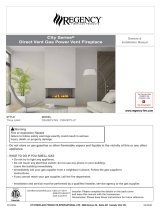 Regency Fireplace Products CitySeries San Francisco Bay 40 Power Vent Owner's manual
Regency Fireplace Products CitySeries San Francisco Bay 40 Power Vent Owner's manual
-
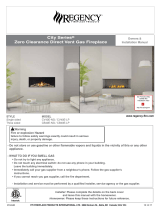 Regency Fireplace Products CitySeries New York View 40 Owner's manual
Regency Fireplace Products CitySeries New York View 40 Owner's manual
-
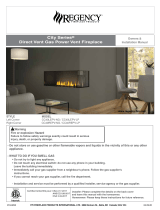 Regency Fireplace Products CitySeries Chicago Corner 40RE Power Vent Owner's manual
Regency Fireplace Products CitySeries Chicago Corner 40RE Power Vent Owner's manual
-
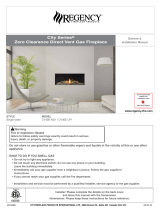 Regency Fireplace Products CitySeries New York View 40 Owner's manual
Regency Fireplace Products CitySeries New York View 40 Owner's manual
-
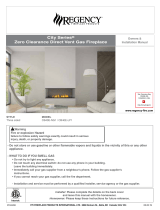 Regency Fireplace Products CitySeries San Francisco Bay 40 Owner's manual
Regency Fireplace Products CitySeries San Francisco Bay 40 Owner's manual
-
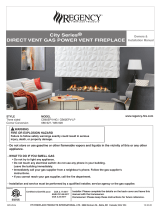 Regency Fireplace Products CitySeries San Francisco Bay 60 Power Vent Owner's manual
Regency Fireplace Products CitySeries San Francisco Bay 60 Power Vent Owner's manual
-
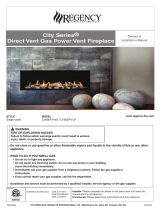 Regency Fireplace Products CitySeries New York View 60 Power Vent Owner's manual
Regency Fireplace Products CitySeries New York View 60 Power Vent Owner's manual
-
 Regency Fireplace Products Liberty L965E Owner's manual
Regency Fireplace Products Liberty L965E Owner's manual
-
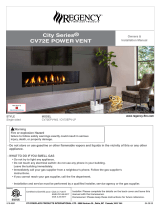 Regency Fireplace Products CitySeries New York View 72 Power Vent Owner's manual
Regency Fireplace Products CitySeries New York View 72 Power Vent Owner's manual
-
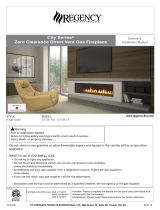 Regency Fireplace Products CitySeries New York View 72 Owner's manual
Regency Fireplace Products CitySeries New York View 72 Owner's manual
Other documents
-
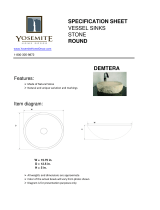 Yosemite Home Decor DEMTERA Installation guide
Yosemite Home Decor DEMTERA Installation guide
-
Fireplace Xtrordinair 864 ST GS2 Scr Fireplace (FPX) 2014 Framing Guide
-
Titan Fitness Pulling Block Set User manual
-
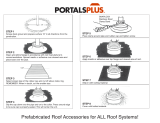 Portals Plus 22035 Installation guide
Portals Plus 22035 Installation guide
-
Regency CITY Series Owners & Installation Manual
-
Klip Xtreme KSD-345 Datasheet
-
Barton 96220-H Operating instructions
-
United States Stove GWCK User manual
-
Redring RIWH6 Inline Instantaneous Water Heater Product information
-
 Aria Vent FLUSH4X10BLK Installation guide
Aria Vent FLUSH4X10BLK Installation guide
















































































































